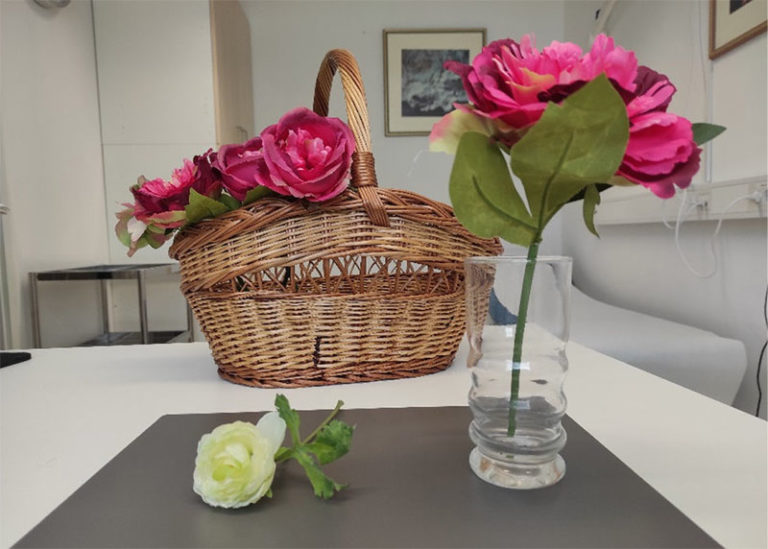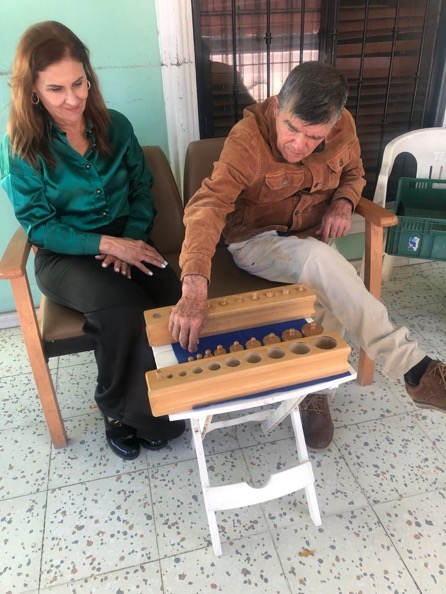Shedding Light on Hallucinations
Visuoperceptual Ability: “Visuoperceptual ability is a component of visual perception that enables recognition of objects based on their form, pattern, and color.” (Irani, F. (2011). Visuoperceptual. In: Kreutzer, J.S., DeLuca, J., Caplan, B. (eds) Encyclopedia of Clinical Neuropsychology. Springer, New York, NY.)
There are a number of visuoperceptual difficulties related to dementia such as:
- Decreased sensitivity to differences in contrast
- Reduced ability to detect movement
- Changes to the visual field
- Reduced ability to detect different colors
- Changes to the reaction of the pupil to light
- Problems directing or changing gaze
- Problems with the recognition of objects, faces and colors
- Loss of ability to name what has been seen
- Double vision
- Problems with depth perception
Common experiences caused by damage to the eyes, or by problems with another part of the visual system and the brain often include:
- Illusions – what the person sees is a “distortion of reality.”
- Misperceptions – what the person sees is a “best guess” at the inaccurate or distorted information the brain has received from the eyes.
- Misidentifications – damage to specific parts of the brain can lead to problems identifying objects and people.
- Hallucinations – an experience of something that is not really there.
Hallucinations can occur for all the senses, although visual hallucinations are the most common.
- Visual hallucinations can be as simple as seeing flashing lights, or as complex as seeing animals, people or strange situations.
- People with dementia are often thought to be hallucinating when in fact they are making a mistake about what they have seen.
Here are some tips for care partners about how to respond when someone is experiencing hallucinations as a result of dementia:
Talk with a medical professional
Pain, medication side effects, dehydration, urinary tract infections, and many more medical issues may all result in hallucinations. Make sure that you report all changes in behavior immediately to the person’s doctor. You may want to speak with your older adult’s doctor to find out if there could be a medical reason behind their hallucination.
Determine if it is bothering the person
If the hallucination is pleasant, you might not want to respond or call attention to it. If the hallucination is upsetting or causing the person to do something unsafe, then it’s time to quickly step in with reassurance and validation.
Put yourself in their shoes
What the person is seeing is very real to them, so don’t argue. Trying to explain that it isn’t real is typically very unsuccessful. In many cases, learning that you don’t believe them might make the person even more upset. Ask the person about what they see. Listen carefully and show your interest and concern. Keep in mind that if the person is language impaired, describing what they see may be very difficult for them.
Validate their feelings
You may think that you should immediately redirect the person to something else, but that can make them feel ignored, not seen or heard, or rejected. Instead of trying to distract them or saying, “There’s nothing there!” focus on acknowledging how they feel about the situation by imaging how you might feel. You might say, “That sounds scary. I can see how upset you are.” You don’t need to pretend that you see something, but you can offer to do something for them that will make them feel safe by asking how you can help.
Assess the environment and remove possible causes or barriers to functioning
Dim lighting, shadows in windows, mirrors, the TV, music or other environmental stimuli may cause the person to think there are strangers in the house or that someone is trying to break into the home. Consider dementia best practices for environment while scanning the room(s) to determine if there may be something that is serving as a trigger.
Keep a journal of observations and look for patterns
If hallucinations happen frequently, there could be a reason that’s not immediately obvious. By using our observation skills, we can determine if there is a pattern related to the time of day, a physical need or discomfort, a particular person in the household, or a specific location. Remember the human tendencies we discuss in our Montessori classes and determine if there are one or more that are not being met.
Engage the person in meaningful activity
Follow the person’s interests and needs and establish a routine during the day that allows them to engage in leisure activities and household chores of their choice. Remember to build in quiet time for music and rest breaks during the day so the person isn’t exhausted by midday, which could in turn trigger more hallucinations or other problems.
For more information about hallucination and other common challenges related to dementia, consider our self-study Can Do! Dementia Care Certification course!





